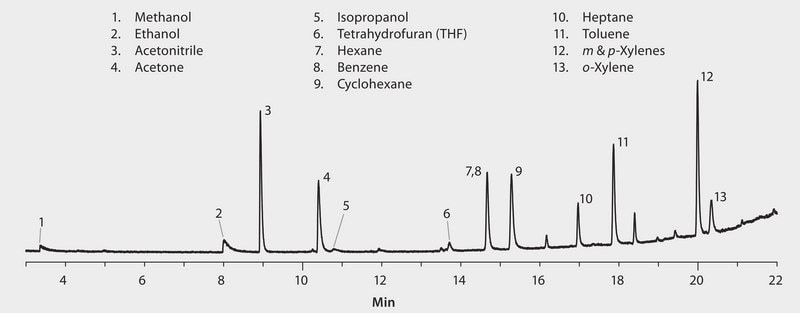GC Analysis of Residual Solvents in Hemp Extract on Supel-Q PLOT after Headspace SPME using 75 μm Carboxen®/PDMS Fiber

Materials
accessory
Headspace vial, screw top, rounded bottom (vial only)
volume 10 mL, clear glass vial, thread for 18, O.D. × H 22.5 mm × 46 mm, pkg of 100 eaMagnetic Screw Cap for Headspace Vials, 18 mm thread
PTFE/silicone septum (white PTFE/blue silicone), septum thickness 1.5 mm, pkg of 100 earelated product
used together
SPME Fiber Assembly
75 μm CAR/PDMS, Fused Silica (1 cm), needle size 24 ga, Autosampler, pk of 3, black hubCONDITIONS
sample preparation
Solid Phase Microextraction
sample/matrix
5 g sample in 10 mL vial
SPME fiber
SPME fiber assembly Carboxen/Polydimethylsiloxane (CAR/PDMS) (57319)
extraction
5 min, headspace, 40 °C
desorption process
3 min, 320 °C; split 10:1
sample preparation
fiber post bake: 2 min, 320 °C
column
Supel-Q PLOT, 30 m x 0.32 mm I.D. (24242)
oven
50 °C (5 min), 10 °C/min to 230 °C (5 min)
inj. temp.
320 °C
detector
MSD
MSD interface
260 °C
scan range
m/z 29-200
carrier gas
helium, 2 mL/min constant flow
injection
split, 10:1
liner
SPME, 0.75 mm I.D.
Description
Analysis Note
Marijuana oil is produced by extraction of the flower buds of the cannabis sativa plant. This process often involves the use of solvents such as hexane or some alcohols. Even though measures are taken to remove these solvents after extraction, some residual material may remain behind in the final product. In this work, headspace SPME was used to analyze residual solvents from an extract of hemp. For the analysis, hemp extract was used for testing in lieu of marijuana extract, which could not be obtained in the location where the work was done. Hemp and marijuana are both varieties of cannabis sativa, however hemp is a variety that is very low in THC content.
Legal Information
Carboxen is a registered trademark of Merck KGaA, Darmstadt, Germany
null